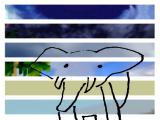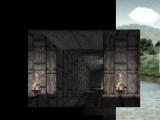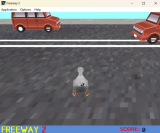Psilocervine's Open World Jamstravaganza - Streamlining Terrain
So! I decided to take part in the Open World Jam and the first realization I had was "this is a terrible idea."
However, that's pretty useless when it comes to getting things done, so I threw it away. Instead of focusing on that, I decided to focus first on streamlining the process of making terrain in Unity, only to be met with the fact that the Unity terrain shader is... kinda awful.

There's constant repeating textures, horrible smearing along sharp inclines, basically everything that drives me up the wall when I play an open world game! Luckily, I am very smart, or at least persistent. The first thing I wanted to tackle was getting rid of the awful tiling pattern since I prefer to create natural looking environments, and repeating patterns in nature generally aren't built along explicit grids. The solution to this problem is something known as Stochastic Sampling.
The idea behind stochastic sampling, at least from a very simplified perspective, is to tile things using a triangle grid with semi-random offsets and blend between the grid elements. If you want a better explanation than I'm able to give, there's a very in-depth paper here (Google Drive link to a PDF). It seems daunting at first, but with a little bit of finagling, I was able to get much better results.

As you can see, the tiling is effectively invisible! The downside to this is that it requires three texture samples to pull off, but even integrated hardware is so overwhelmingly beefy and bandwidth capable enough that that's not much of an issue. On top of that, stochastic sampling means I can get away with lower resolution textures in the first place. Unfortunately, we can still see some very ugly smearing. Fortunately, this is also much easier to fix because all it requires is something known as Triplanar Mapping.
Triplanar mapping is much easier to explain than stochastic sampling, thank god. Effectively, you're projecting the textures towards three different normal axes and blending them: X,Y, and Z. Again, this requires sampling three times, which is some overhead, but thanks to the stochastic sampling there's not a terrible amount of overhead. It DOES mean that my texture coordinates are now in World Space, which takes some adjustments, but by applying this method, we get some suddenly wonderful results!

Smearing? Gone! Tiling? Gone! Self-confidence? Through the roof baybeeeeeeeeeeeeeeeeeeee! Most of what was left was really just generic cleanup and making things play nice with Unity's terrain tools. By including a reference to the _Control texture sampler in my shader, I'm able to use four environment textures and paint them the same way I would a standard Unity terrain, but with none of the gross texture distortions. I can even paint holes in the texture by adding the _TerrainHolesTexture sampler. This is a massive boon even if it took a couple days to get to work because it massively streamlines dealing with terrain.


Now there is one last problem: authoring terrain in Unity is a dreadful experience. You really don't get much control over the specifics of the terrain, such as height and other features, and making terrain stamps only gets you partly there. Rather than let Unity control me like some kinda game engine cop, I cut it out of that part of the equation and took to Blender instead. Really there's nothing amazing going on here as I haven't gotten terribly far, but the general process is
1. Create a terrain in Blender
2. Join the meshes together in a big mess
3. Export that mesh to Unity
4. Use a free utility called Object2Terrain to convert that mesh into a terrain


In a perfect world (men like me would not exist, but this is not a perfect world) I would simply export a heightmap from Blender and use that heightmap to drive the Unity terrain, but Unity's terrain only accepts heightmaps in RAW format, which is notoriously difficult to export to from just about anything aside from expensive terrain authoring tools. Thankfully, Object2Terrain works a treat.
That's all for now, I suppose! I'm very pleased with the progress I've made, since it makes content authoring a lot easier on the terrain front, and that's always a tricky spot with open world games.






Comments
that smearing has always
that smearing has always driven me up the world too and it's never changed even since the old days. all terrains in video games just do it by default and it looks awful. I had no idea fixes existed at all. It's so bad for me I tend to never use terrain at all.
this is really cool and I love seeing the technical side of what people are doing for this jam.